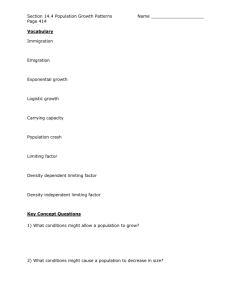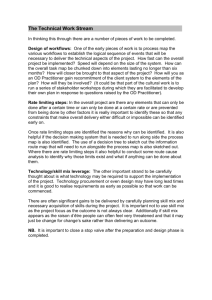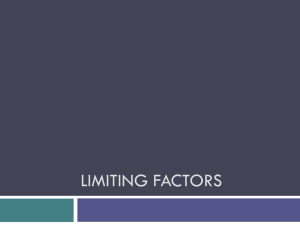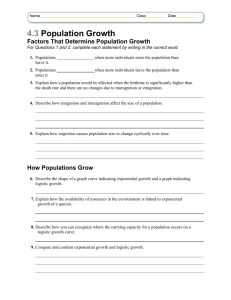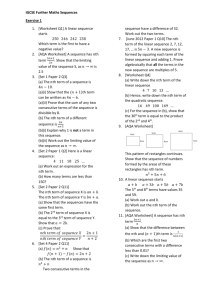Colleen Snow Lesson plans for Biology Week 17, November 28
advertisement
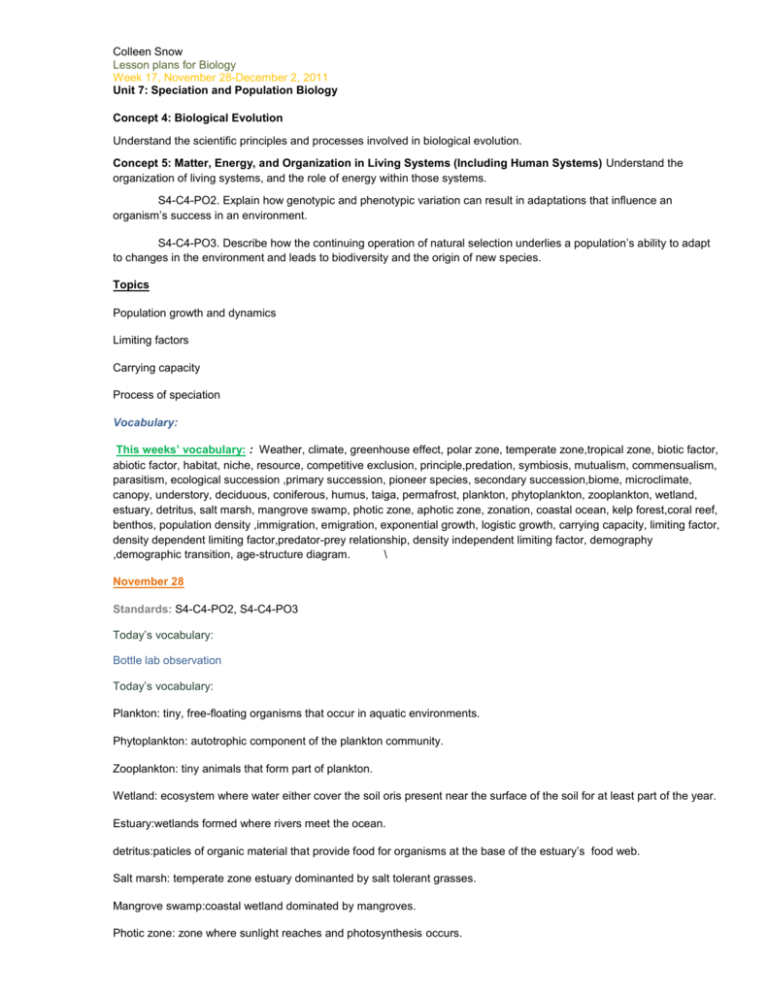
Colleen Snow Lesson plans for Biology Week 17, November 28-December 2, 2011 Unit 7: Speciation and Population Biology Concept 4: Biological Evolution Understand the scientific principles and processes involved in biological evolution. Concept 5: Matter, Energy, and Organization in Living Systems (Including Human Systems) Understand the organization of living systems, and the role of energy within those systems. S4-C4-PO2. Explain how genotypic and phenotypic variation can result in adaptations that influence an organism’s success in an environment. S4-C4-PO3. Describe how the continuing operation of natural selection underlies a population’s ability to adapt to changes in the environment and leads to biodiversity and the origin of new species. Topics Population growth and dynamics Limiting factors Carrying capacity Process of speciation Vocabulary: This weeks’ vocabulary: : Weather, climate, greenhouse effect, polar zone, temperate zone,tropical zone, biotic factor, abiotic factor, habitat, niche, resource, competitive exclusion, principle,predation, symbiosis, mutualism, commensualism, parasitism, ecological succession ,primary succession, pioneer species, secondary succession,biome, microclimate, canopy, understory, deciduous, coniferous, humus, taiga, permafrost, plankton, phytoplankton, zooplankton, wetland, estuary, detritus, salt marsh, mangrove swamp, photic zone, aphotic zone, zonation, coastal ocean, kelp forest,coral reef, benthos, population density ,immigration, emigration, exponential growth, logistic growth, carrying capacity, limiting factor, density dependent limiting factor,predator-prey relationship, density independent limiting factor, demography ,demographic transition, age-structure diagram. \ November 28 Standards: S4-C4-PO2, S4-C4-PO3 Today’s vocabulary: Bottle lab observation Today’s vocabulary: Plankton: tiny, free-floating organisms that occur in aquatic environments. Phytoplankton: autotrophic component of the plankton community. Zooplankton: tiny animals that form part of plankton. Wetland: ecosystem where water either cover the soil oris present near the surface of the soil for at least part of the year. Estuary:wetlands formed where rivers meet the ocean. detritus:paticles of organic material that provide food for organisms at the base of the estuary’s food web. Salt marsh: temperate zone estuary dominanted by salt tolerant grasses. Mangrove swamp:coastal wetland dominated by mangroves. Photic zone: zone where sunlight reaches and photosynthesis occurs. Aphotic zone: zone where no sunlight reaches. Zonation: prominent horizontal banding of organisms that live in a particular habitat. 42. Coastal ocean: marine zone that extends from the low-tide mark to the continental shelf. Kelp forest:coastal ocean community named for its dominant organism. Coral reef: diverse and productive environment named for primary animals. Benthos: organism that live on or near the ocean bottom. Read pp. 106-112 Objectives: At the end of this lesson, student will be able to: Describe the main factors that govern aquatic systems. Discuss the two types of freshwater ecosystems. Differentiate between the marine zones. November 29 Standards: S4-C4-PO2, S4-C4-PO3 Today’s vocabulary: Population density: number of individuals per unit of area. Immigration: movement of individuals into an area. Emigration: movement of individuals out of an area. Exponential growth: growth patterns where individuals multiply at a constant rate. Logistic growth: growth patterns where individuals slows or stops following a period of exponential growth. Carrying capacity: the largest number of individuals that a population in an area can support. Read pp. 119-123 Worksheet on populations and exponential growth. Interpreting Ecological Data Access worksheet downloads @ http://colleen_snow.azschool.com Objectives: At the end of this lesson, student will be able to: List characteristics that are used to describe a population. Determine what factors affect population size. Differentiate between exponential and logistical growth November 30 Standards: S4-C4-PO2, S4-C4-PO3 Today’s vocabulary: Limiting factor: factor that causes a population to decrease. Density dependent limiting factor: limiting factor that depends on population size. Predator-prey relationship: population control by predation. Density independent limiting factor: limiting factor that affects all populations, regardless of size. Read pp. 124-128 Worksheet on predation. Predation or Starvation. Access worksheet downloads @ http://colleen_snow.azschool.com Objectives: At the end of this lesson, student will be able to: Describe what factors limit populations December 1 Standards: S4-C4-PO2, S4-C4-PO3 Today’s vocabulary: Demography: the characteristics of a population in an area. Demographic transition: change in the characteristics of a population in an area. Age-structure diagram: graph of the number of males and females in a population and their ages. Read pp. 129-132 Worksheet on population growth: Human population Growth Objectives: At the end of this lesson, student will be able to: Describe how the size of human population has changed over time. Explain why population growth rates vary by country. Unit 8: Humans in the Biosphere Vocabulary: Subsistence hunting, agriculture, green revolution, monoculture, renewable resourcenonrenewable resource, sustainable use, soil erosion,desertification, deforestation, aquaculture,smog, pollutant, acid rain, biodiversity ecosystem, diversity, species diversity, genetic diversity, extinction, endangered species, habitat fragmentation, biological magnification, invasive species, conservation. Standards Concept 1: Changes in Environments Describe the interactions between human populations, natural hazards, and the environment.S3-C1-PO1. Evaluate how the processes of natural ecosystems affect, and are affected by, humans. S3-C1-PO2. Describe the environmental effects of the following natural and/or human-caused hazards: • flooding • drought • earthquakes • fires • pollution • extreme weather S3-C1-PO3. Assess how human activities (e.g., clear cutting, water management, tree thinning) can affect the potential for hazards. S3-C1-PO4. Evaluate the following factors that affect the quality of the environment: • urban development • smoke • volcanic dust S3-C1-PO5. Evaluate the effectiveness of conservation practices and preservation techniques on environmental quality and biodiversity. S3-C3-PO1. Analyze social factors that limit the growth of a human population, including: • affluence • education • access to health care Topics Renewable and nonrenewable resources December 2 Standards: S3-C1-PO1.S3-C1-PO2. S3-C1-PO3. S3-C1-PO4. S3-C1-PO5. S3-C3-PO1. Vocabulary: Subsistence hunting, agriculture, green revolution, monoculture, renewable resource, nonrenewable resource, sustainable use, soil erosion,desertification, deforestation, aquaculture,smog, pollutant, acid rain, biodiversity ecosystem, diversity, species diversity, genetic diversity, extinction, endangered species, habitat fragmentation,biological magnification, invasive species, conservation. Today’s vocabulary: Subsistence hunting: most or all food is obtained from wild plants and animals. Agriculture: land maintained to grow food for many. green revolution: a series of research, development, and technology transfer initiatives, occurring between the 1940s and the late 1970s, that increased agriculture production around the world, beginning most markedly in the late 1960s. Monoculture : the agricultural practice of producing or growing one single crop over a wide area. Read pp. 139-143 Objectives: At the end of this lesson, student will be able to: Describe how human activities affect the biosphere.

